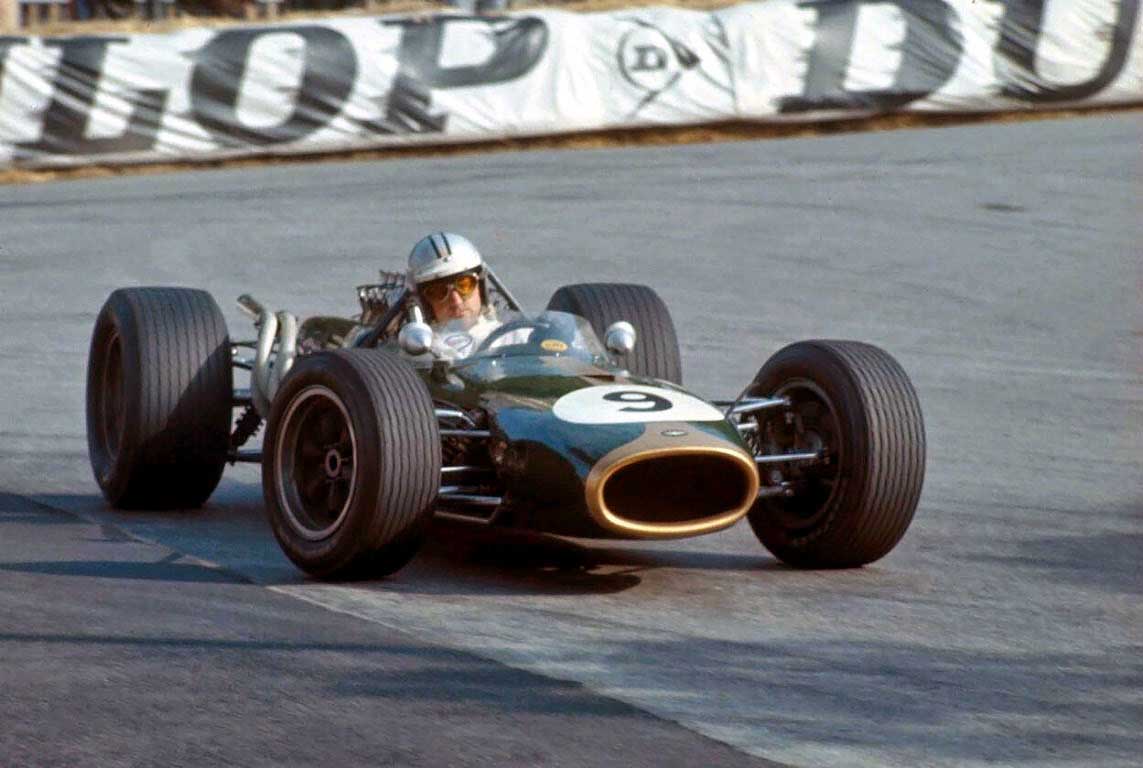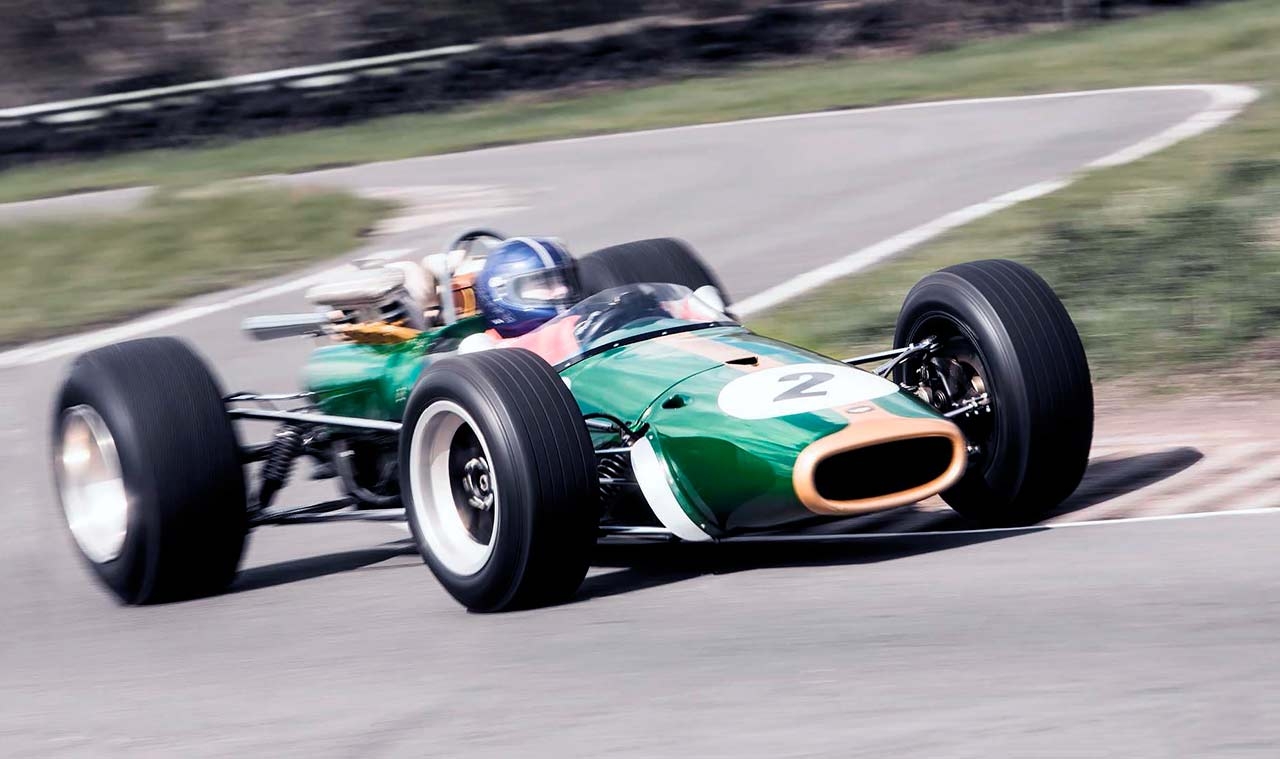
In 1967 Denny Hulme overcame all odds to retain the F1 title for Brabham. Fifty years on, we drive the BT24 in which the Bear became the King. Words Ivan Ostroff. Photography Glenn Lindberg. On the edge in Denny Hulme’s Brabham BT24. Pipe Dream We slide down into Denny Hulme’s seat for a sensory-overwhelming on-limit drive of his World Championship-winning Brabham BT24.
Sitting on the Brabham’s left rear wheel, I watch Rob Hall as he pours fuel into a tank directly below the seat into which I’m about to place my backside. ‘A bit worrying that; it brings a whole new meaning to hot seat,’ I quip nervously. Safety in Formula 1 racing cars really has come a long way since 1967. I’ve been fortunate enough to talk my way into several famous racing cars in my time, but this time it feels different; eerily surreal. I can feel the goosebumps and I can hardly believe that I’m actually about to sit in the 1967 Formula 1 World Championship-winning Brabham BT24/2, let alone be allowed to drive it.
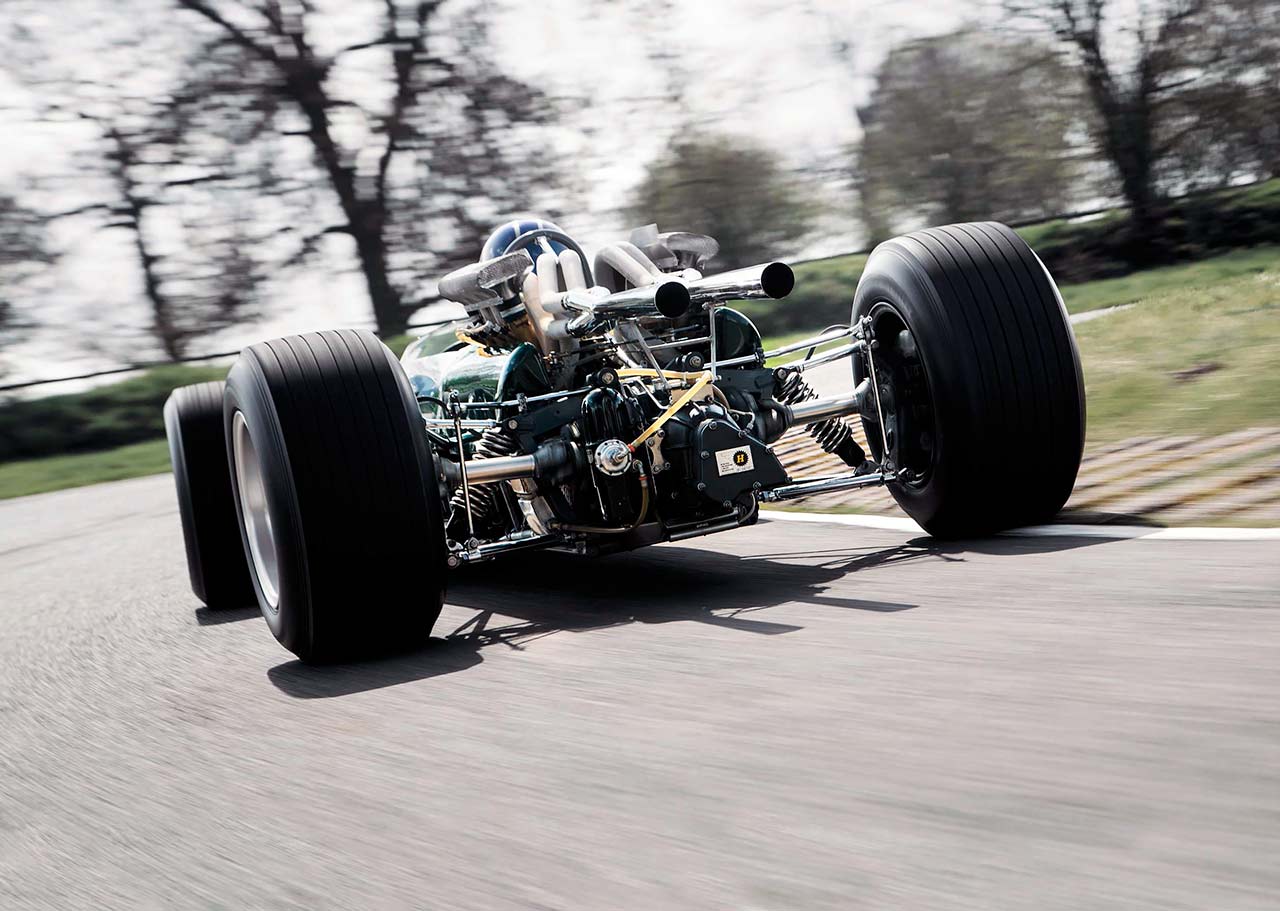
At last we’re all done with fueling. Rob moves around to the front and begins fitting the nosecone in place as I prepare to board. The Brabham BT24 is low; you don’t so much sit in it as lay fully reclined with your body millimeters from the ground, feeling very much part of the car. Once I’ve slid down into the cockpit, I’m snug but my feet are down next to the battery and I wonder how on earth I’d get them out in a hurry. No wonder Jackie Stewart wanted safety changes. I rest my feet on the grippy cork pads bonded to the clutch and brake pedals and decide not to worry about such things.
I lick the switches for the electrics and fuel pump, then wait for the fuel pressure to come up. Showing 120psi now, that’s OK. I can’t hear the pump through my helmet, but my heart is banging in my chest with expectation as I press the starter button. The Brabham’s Repco 740 3.0-litre V8 starts pretty much instantly; that I do hear reverberating triumphantly through my crash hat. I sense Rob looking over my shoulder checking everything, and with the water temperature now hovering just below 80 degrees I’m satisfied that everything is warming through nicely.
I grasp the stubby gear lever with my right hand, then move it left and back into first. It feels heavily sprung but the movement through the remote linkage all the way back to the Hewland DG300 gearbox stuck out at the rear is short, light and utterly precise. I often wondered what DG stood for until recently – apparently when Mike Hewland was designing the gearbox, a colleague looking over his shoulder asked him, ‘is that a Different Gearbox you are working on?’ But this is no time for digression; I watch the staccato jumps of the rev counter needle respond to my blipping of the loud pedal as I get the feel of the throttle, then engage the clutch smoothly but positively. As the Brabham trickles forward I notice my knee is touching the gear lever. Irritating.
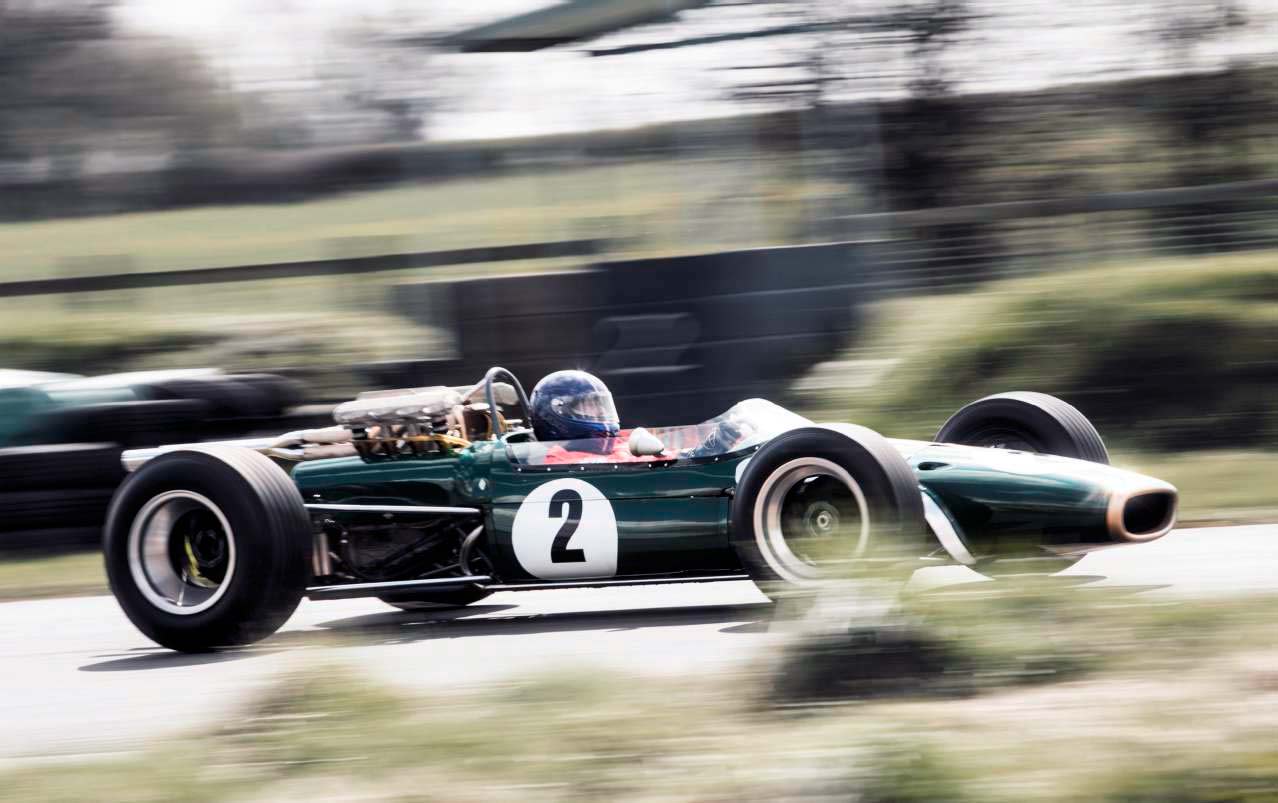
Low in the cockpit, I’m sheltered from the building wind resistance with my arms straight and my hands grasping the leather-rimmed aluminium steering wheel that Denny ‘The Bear’ Hulme held 50 years ago as he won the F1 World Championship. I lean into the first left-hand corner, mesmerised by the front uprights and the big Dunlops dancing over the blurring black bitumen. The tachometer needle swings through 4000rpm, and I push the gear lever forward and right into second gear and accelerate, revelling in the Repco V8’s gorgeous howl.
I get used to the feel of the car quicker than I expected. Once warm, the brakes are powerful and effective and I feel good about the BT24’s handling. Exiting the next left-hander, I squeeze the throttle and savour that exquisite moment of mechanical perfection as the car slides under power. You have to be positive and confident with this machine; lose your bottle and things get untidy as the car gets out of balance. But get it right and you really cannot imagine anything more satisfying.
I remember my instructions – slow in, fast out. Hanging the tail out was Black Jack Brabham’s racing style, honed on the Australian dirt tracks where he fatefully met this car’s engineer Ron Tauranac – and the car loves it. After pulling back into third for the the next right-hander I jab the throttle as I clip the apex, and catch the resulting slide with a lick of the wheel and a trail of the accelerator before getting back on the power. Not too much, just keep it balancing on the edge like a ballerina on her toes – you don’t want to tip her over, just keep her up on her points. It’s an addictive routine, one that must be practiced using instinct and confidence. Quite suddenly it occurs to me that I’m grinning childishly in my helmet and I feel like a delirious idiot.
Down the straight again, this time I hold it to 5800rpm – with Rob’s prior permission – and I can feel the seat pressing against my body as 330bhp catapults a Brabham-plus-driver mass of around 600kg in the general direction of tomorrow. I nudge the gearstick forward, across and up into fourth. I have a few seconds to appreciate the unrepentant bellowing of the Repco V8 behind me before I have to get on the brakes again in readiness for the next corner. As the pads bite onto the Girling discs and I watch the front suspension compress, I’m held back back by my harness as the Brabham slows. The right side of my heel blips the gas as I stab the clutch while positively selecting second – once you get used to the DG gearbox and overcome the errant placement of the lever, it’s remarkable quick. Purposely turning in late, I feed the merest touch of extra lock then at the same instant get on the throttle as I dial in some very real opposite lock as the car slides under power. Again, tilting my head quite instinctively into the corner, I watch the angled coil-over shocks stutter and the front wheels dance while the all-independent suspension works in perfect harmony. I feed the merest of corrective input via the MRD rack, the car settles itself and gets straight again.
Once I’m used to the feel of the brakes, I gradually allow myself to brake later and later. Until the inevitable happens; approaching the hairpin I heel and toe down into second, but this time I’ve left it late and the tail gets a bit too unsettled. Once all is safely collected up again and heart retracts back down throat, I decide that from now on I will be following Rob’s slow-in, fast-out advice to the letter. I am no Bear or Black Jack.
After Black Jack had won the F1 World Championship driving Coopers in both 1959 and 1960, he’d asked old pal Ron Tauranac to join him in England and develop racing cars. Together they formed Motor Racing Developments; the first car Tauranac designed for MRD was the 1961 Formula Junior car. In 1962 Black Jack entered his first Brabham-badged F1 car, the BT3.
When the FIA announced the ‘Return of Power’ 3.0-litre formula was to replace the earlier 1.5-litre formula for the 1966 season, Brabham needed a car and an engine. Tauranac had designed and constructed a spaceframe chassis specifically to take the stillborn lat-16 engine that Coventry Climax was developing in 1964/5. Fortunately that chassis was not destroyed, but simply dumped in a corner of the Brabham Racing Organisation workshops. It was dusted down and ‘lashed up’, in Tauranac’s words, with an Oldsmobile F85-derived 3.0-litre V8 built by Repco of Australia. That became the Brabham BT19 – good simple engineering that looked right and went right, enabling Jack Brabham to win both the 1966 Formula 1 World Drivers’ Championship and the World Manufacturers’ Championship in his own car.
The magnitude of repeating that legendary feat became apparent when the Cosworth DFV-engined Lotus 49 arrived a few races into the 1967 season. Debuting at the same time, the new Brabham BT24 looked to have been rendered instantly obsolete. The 330bhp Repco-Brabham 740 engine appeared significantly underendowed on paper compared to the Cosworth’s 408bhp, or the 417bhp claimed for Dan Gurney’s Eagle-Weslake unit. However, the Brabham-Repco’s superior agility and bulletproof reliability more than compensated for any power deficit.
The title-defending car was based on the BT19, but this time had been designed as a 3.0-litre Formula 1 car from the outset. Simplicity was the keynote throughout – while Lotus and the other F1 manufacturers were moving over to monocoque designs, Tauranac resolutely employed a spaceframe chassis. As well as having the advantage of being strong, light and compact, the spaceframe was easier and cheaper to repair – attributes that Tauranac felt would encourage privateers to order similar cars from the Brabham Racing Organisation.
Front suspension comprised unequal length and non-parallel front wishbones, and specially cast uprights in place of the Triumph Herald units of the previous cars. The rear end featured single top links and reversed lower wishbones, again with specially cast magnesium uprights. The Repco engine had evolved to better withstand the strains and stresses of racing, with a new alloy crankcase, wet liners and cross-bolted main bearing caps.
Tauranac asked Repco to site the exhausts within the vee of the engine – to improve aerodynamics and eliminate the need to run pipes around the rear suspension – so new cylinder heads were developed. The heads maintained parallel valves but were now in line and lush with the face of the head. Ultimately, the 740 Series engine weighed 30lb less than the 620 Series it usurped
This car, BT24/2, was first raced by Hulme at the 1967 French Grand Prix. Initially the Lotus-Fords dominated but after they both retired with broken transmissions, Black Jack and The Bear were uncatchable and finished in first and second place respectively. At the British Grand Prix Brabham’s BT24/1 finished fourth but Denny’s car was second and also set the fastest lap at 1m 27s, averaging 121.12mph. At the German GP it was a Hulme- Brabham one-two again after Dan Gurney’s Eagle and both Lotuses packed up. The Brabham cars ran faultlessly again at Mosport, their superb handling coming to the fore in the torrential rain. Here Brabham won and Hulme came second.
The final championship race of the 1967 season was at Watkins Glen where Jim Clark won, Brabham was second and Hulme third. That left Denny Hulme as the 1967 World Champion and Brabham winner of the World Manufacturers Championship. Against worse odds – and stiffer competition – they’d done it again.
Following Hulme’s move to McLaren, Brabham BT24/2 was driven by the Jochen Rindt when he inished in third spot at the 1968 season-opening South African Grand Prix at Kyalami. With the more powerful (but ultimately less reliable) BT26 waiting in the wings, the car was sold directly after the race to Team Gunston for Sam Tingle. He went on to score many podiums and finished third overall in the 1969 South African Drivers Championship that was run to F1 regulations. The Tingle family then kept the car for four decades.
‘There’s nothing worse for a racing car than a long period of inactivity,’ says Rob Hall. ‘The seals fail, the brakes seize; the best thing for a historic racer is to use it every now and then so everything gets up to temperature and all the rubber components are kept soft and supple.’ That said, the car has required little attention other than basic maintenance since Hall & Hall took BT24/2 under its wing three years ago.
‘There’s nothing trick in the construction of the car,’ Rob continues. ‘It’s very simple and conventional, and very well built. While everyone else was getting themselves all involved with new monocoque designs, Brabham went and won two World Championships by keeping things simple – simple engine, simple Sixties space-frame construction. If the chassis was damaged, a few new tubes here and there and you were back in business.’
The only change Hall & Hall made to BT24/2 was fitting a safer bag tank behind the driver. Originally this space was occupied by was one of several aluminium tanks – others were located on each side of the driver running from just in front of the engine almost down to the drivers feet, across the driver’s knees, behind the seat and, for longer circuits like Monza, squeezed in below the knees. They’re still present and plumbed in, but nowadays the bag tank holds plenty enough for the car’s less taxing demonstration duties such as runs up the hill at the Goodwood Festival of Speed. Safety has indeed come a long way in 50 years – as has the importance of human life and the value of this irreplaceable car.
Before I run it dry – or settle a little too comfortably into the straight-armed stance of a heroic Sixties F1 driver – I realise I’ve completed as many laps as the bag tank, or Rob Hall, will sustain. I pull into the paddock, cut the switches and roll to a halt. I take of my helmet, haul my balaclava over my sweaty head and stay sitting in The Bear’s Brabham, reluctant to accept that the experience has ended. Sitting in the hallowed cockpit, I listen to that V8 masterpiece ping and click and as it cools down, monochrome daydreams of Hulme’s victory abounding. I’ve just enjoyed the amazing privilege of driving a paragon of golden-era of motor racing. My time in the hot seat isn’t one I’m likely to forget.
Thanks to Rob Hall at Hall & Hall
Tech and photo
TECHNICAL DATA FILE SPECIFICATIONS 1967 Brabham BT24/2
Engine 2996cc Repco-Brabham 740 alloy V8, sohc per bank, Lucas mechanical fuel injection
Power 330bhp @ 8000rpm (DIN)
Transmission Five-speed Hewland DG300 ZF, crown wheel & pinion
Steering MRD rack and pinion
Suspension All independent. Front: leading and trailing wishbones, anti-roll bar, coil-over dampers. Rear: reverse lower wishbones, single top link, twin top and bottom radius rods, anti-roll bar, coil-over dampers
Brakes Girling discs all round
Performance Top speed: 180mph
Wheelbase 2370mm
Weight 568kg (1252lb)
Price new £540,000
Current value Approx £11.5m
‘My instructions are to go slow-in, fast-out – just keep it balancing on the edge like a ballerina on her toes’
‘Against worse odds – and stiffer competition – Brabham had done it again’
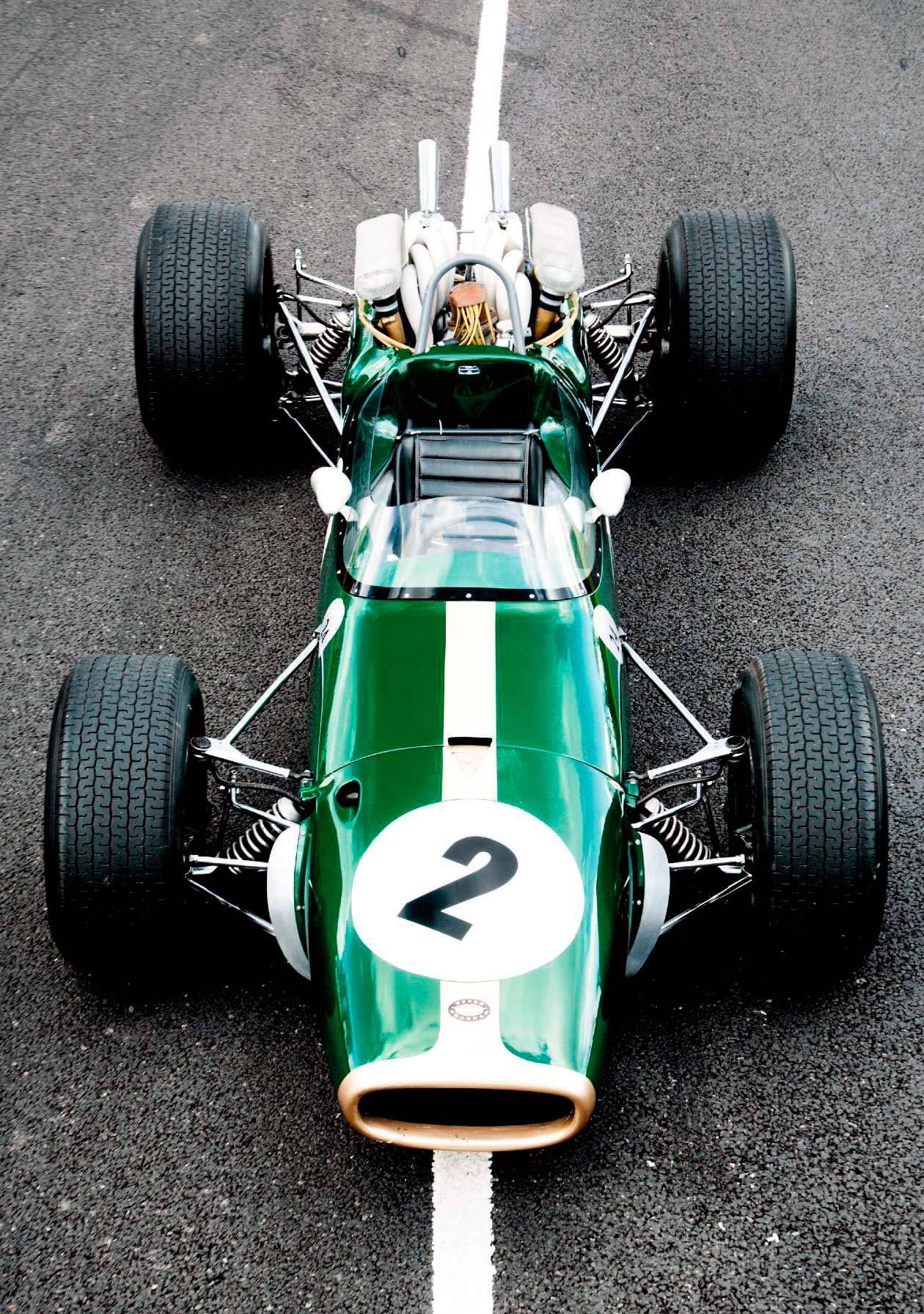
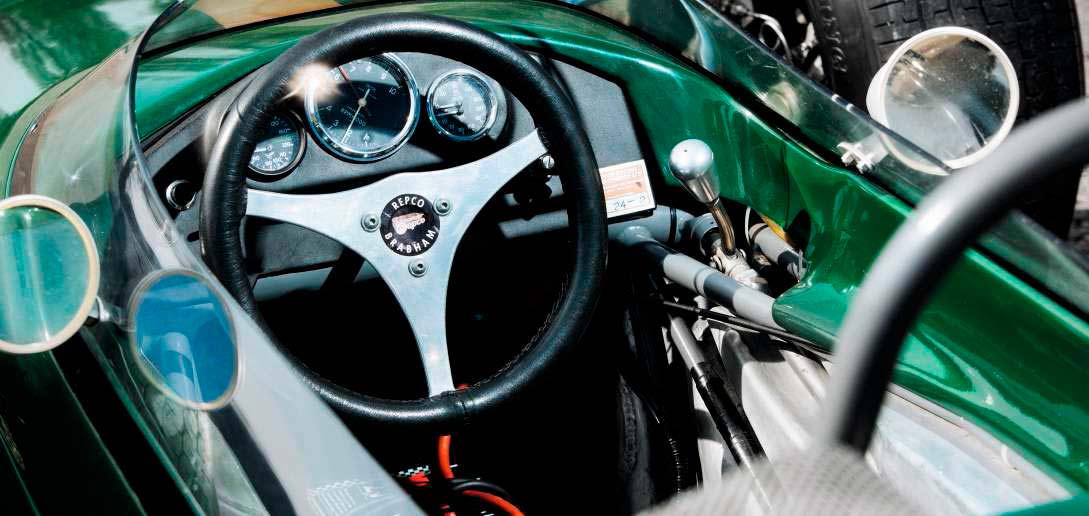
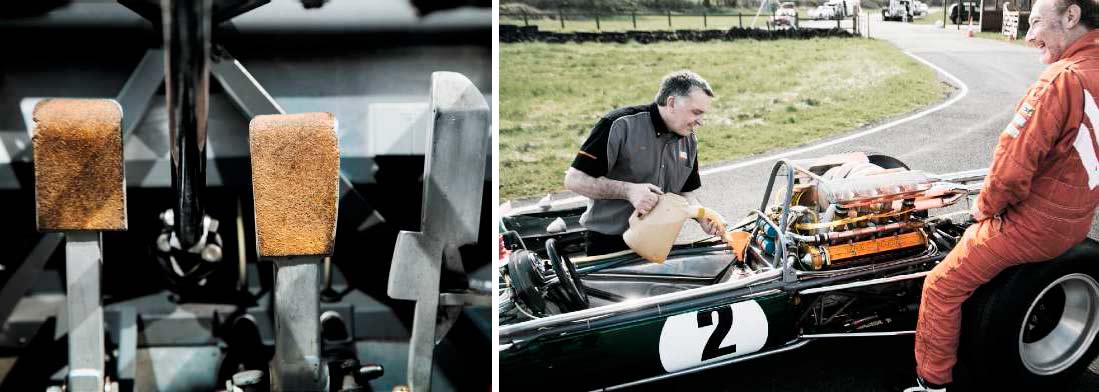
DENNY HULME, 1936-1992
Denis Clive Hulme was born on 18th June 1936 in Motueka, New Zealand. He came second at Le Mans in 1966 and won the Formula 1 World Championship for Brabham in 1967, finishing third in 1968 and in 1972.
After leaving the Brabham Racing Organisation, Hulme drove for Bruce McLaren in Formula 1, the Indianapolis 500 and importantly CanAm – the Canadian-American race series. His exceptional talents as a CanAm driver together with Bruce McLaren in the thunderous McLaren Group 7 sports racers were to become legendary – known as ‘The Bruce and Denny Show’.
Hulme won the Can-Am Drivers’ Championship twice and was runner-up four times. After retiring from F1 at the end of the 1974 season, Hulme continued to compete in Australian Touring Cars.
Because of his appearance and sometime gruff manner, Hulme was often referred to as ‘The Bear’ but was generally well liked and extremely popular with competitors and fans. His services to motor sport were recognised when he was awarded the OBE. Denny Hulme died suddenly of a heart attack on 4 October 1992 while at the wheel of a BMW M3 that he was racing in the Bathurst 1000 in Australia.
